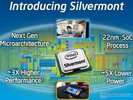Intel Atom Z3735D vs Intel Atom Z3735G
Intel Atom Z3735D
► remove from comparison
Der Intel Atom Z3735D ist ein sparsamer Quad-Core-SoC für Tablets (hauptsächlich Android), der Mitte 2014 vorgestellt wurde. Er taktet mit bis zu 1,83 GHz und gehört der Bay Trail-T Plattform an. Dank eines speziell für Low-Power-Chips optimierten 22-Nanometer-Prozesses (P1271) mit Tri-Gate-Transistoren konnte die Performance sowie die Energieeffizienz gegenüber dem Vorgänger deutlich gesteigert werden. Im Vergleich mit dem Z3745D besitzt der Z3735D eine etwas geringere GPU-Taktrate.
Architektur
Die Prozessorkerne basieren auf der neuen Silvermont-Architektur, welche erstmals bei einem Atom-Prozessor als Out-of-order-Design ausgeführt wurde. Die dadurch erhöhte Auslastung der Pipeline sowie viele weitere Detailverbesserungen (optimierte Sprungvorhersage, vergrößerte Buffer, verbesserte Decoder) sollen die Pro-MHz-Leistung um etwa 50 Prozent steigern. Gleichzeitig entfällt allerdings das Hyper-Threading-Feature der Vorgängermodelle. Weitere wichtige Änderungen umfassen die Unterstützung neuer Befehlssatzerweiterungen wie SSE 4.1 und 4.2 sowie AES-NI (modellabhängig).
Performance
Dank 4 CPU-Kernen und einer Taktrate von bis zu 1,83 GHz übertrifft die Performance bisherige Atom-Modelle wie den Z2760 deutlich. Je nach Benchmark liegt der Z3735D damit in etwa zwischen den Kabini-APUs A6-1450 und AMD A4-5000, sodass ausreichende Leistungsreserven für die meisten Office- und Multimedia-Anwendungen bestehen. Lediglich anspruchsvollere Windows-Software überfordert den SoC, was insbesondere an der vergleichsweise niedrigen Pro-Thread-Leistung liegt. Im Android-Bereich zählt der Z3735D zum oberen Performance-Segment.
Grafik
Die HD Graphics (Bay Trail) basiert auf Intels-Gen7-Architektur, welche DirectX 11 unterstützt und auch bei den Grafiklösungen der Ivy-Bridge-Serie (z.B. HD Graphics 4000) zum Einsatz kommt. Mit nur 4 EUs und maximal 646 MHz Taktrate fällt die Leistung aber noch deutlich niedriger als bei der HD Graphics (Ivy Bridge) aus. Verglichen mit der Android-Konkurrenz entspricht die Performance etwa der Adreno 320 von Qualcomm.
Leistungsaufnahme
Der gesamte SoC wird von Intel mit einer SDP von 2,2 Watt spezifiziert, was eine TDP von unter 4 Watt impliziert. Damit kann der Chip in passiv gekühlten Tablets eingesetzt werden.
Intel Atom Z3735G
► remove from comparison
Der Intel Atom Z3735G ist ein sparsamer Quad-Core-SoC für Tablets (hauptsächlich Android), der Mitte 2014 vorgestellt wurde. Er taktet mit bis zu 1,83 GHz und gehört der Bay Trail-T Plattform an. Dank eines speziell für Low-Power-Chips optimierten 22-Nanometer-Prozesses (P1271) mit Tri-Gate-Transistoren konnte die Performance sowie die Energieeffizienz gegenüber dem Vorgänger deutlich gesteigert werden. Im Vergleich mit dem Z3735E besitzt der Z3735G ebenfalls nur einen 32 Bit Single-Channel Speichercontroller (max. 1 GB DDR3L-RS-1333), kommt jedoch in einem anderen BGA-Package daher.
Architektur
Die Prozessorkerne basieren auf der neuen Silvermont-Architektur, welche erstmals bei einem Atom-Prozessor als Out-of-order-Design ausgeführt wurde. Die dadurch erhöhte Auslastung der Pipeline sowie viele weitere Detailverbesserungen (optimierte Sprungvorhersage, vergrößerte Buffer, verbesserte Decoder) sollen die Pro-MHz-Leistung um etwa 50 Prozent steigern. Gleichzeitig entfällt allerdings das Hyper-Threading-Feature der Vorgängermodelle. Weitere wichtige Änderungen umfassen die Unterstützung neuer Befehlssatzerweiterungen wie SSE 4.1 und 4.2 sowie AES-NI (modellabhängig).
Performance
Dank 4 CPU-Kernen und einer Taktrate von bis zu 1,83 GHz übertrifft die Performance bisherige Atom-Modelle wie den Z2760 deutlich. In Multi-Thread-Benchmarks liegt der Z3735G in etwa auf dem Level der AMD Kabini-APU A6-1450, rechnet bei Belastung nur eines Kernes jedoch etwas langsamer. Dennoch bestehen für die meisten Office- und Multimedia-Anwendungen ausreichende Leistungsreserven. Im Android-Bereich zählt der Z3735G zum oberen Performance-Segment.
Grafik
Die HD Graphics (Bay Trail) basiert auf Intels-Gen7-Architektur, welche DirectX 11 unterstützt und auch bei den Grafiklösungen der Ivy-Bridge-Serie (z.B. HD Graphics 4000) zum Einsatz kommt. Mit nur 4 EUs und maximal 646 MHz Taktrate fällt die Leistung aber noch deutlich niedriger als bei der HD Graphics (Ivy Bridge) aus. Verglichen mit der Android-Konkurrenz entspricht die Performance etwa der Adreno 320 von Qualcomm.
Leistungsaufnahme
Der gesamte SoC wird von Intel mit einer SDP von 2,2 Watt spezifiziert, was eine TDP von unter 4 Watt impliziert. Damit kann der Chip in passiv gekühlten Tablets eingesetzt werden.
| Model | Intel Atom Z3735D | Intel Atom Z3735G | ||||||||||||||||||||||||||||||||||||||||||||||||||||||||||||||||||||||||||||||||||||||||||||||||||||||||||||||||||||||||||||||||||||||||||||||||
| Codename | Bay Trail-T | Bay Trail-T | ||||||||||||||||||||||||||||||||||||||||||||||||||||||||||||||||||||||||||||||||||||||||||||||||||||||||||||||||||||||||||||||||||||||||||||||||
| Series | Intel Atom | Intel Atom | ||||||||||||||||||||||||||||||||||||||||||||||||||||||||||||||||||||||||||||||||||||||||||||||||||||||||||||||||||||||||||||||||||||||||||||||||
| Serie: Atom Bay Trail-T |
|
| ||||||||||||||||||||||||||||||||||||||||||||||||||||||||||||||||||||||||||||||||||||||||||||||||||||||||||||||||||||||||||||||||||||||||||||||||
| Clock | 1330 - 1830 MHz | 1330 - 1830 MHz | ||||||||||||||||||||||||||||||||||||||||||||||||||||||||||||||||||||||||||||||||||||||||||||||||||||||||||||||||||||||||||||||||||||||||||||||||
| L1 Cache | 224 KB | 224 KB | ||||||||||||||||||||||||||||||||||||||||||||||||||||||||||||||||||||||||||||||||||||||||||||||||||||||||||||||||||||||||||||||||||||||||||||||||
| L2 Cache | 2 MB | 2 MB | ||||||||||||||||||||||||||||||||||||||||||||||||||||||||||||||||||||||||||||||||||||||||||||||||||||||||||||||||||||||||||||||||||||||||||||||||
| Cores / Threads | 4 / 4 | 4 / 4 | ||||||||||||||||||||||||||||||||||||||||||||||||||||||||||||||||||||||||||||||||||||||||||||||||||||||||||||||||||||||||||||||||||||||||||||||||
| TDP | 4 Watt | 4 Watt | ||||||||||||||||||||||||||||||||||||||||||||||||||||||||||||||||||||||||||||||||||||||||||||||||||||||||||||||||||||||||||||||||||||||||||||||||
| Technology | 22 nm | 22 nm | ||||||||||||||||||||||||||||||||||||||||||||||||||||||||||||||||||||||||||||||||||||||||||||||||||||||||||||||||||||||||||||||||||||||||||||||||
| Socket | UTFCBGA1380 | UTFCBGA592 | ||||||||||||||||||||||||||||||||||||||||||||||||||||||||||||||||||||||||||||||||||||||||||||||||||||||||||||||||||||||||||||||||||||||||||||||||
| Features | Intel HD Graphics (Bay Trail, 313 - 646 MHz), Quick Sync, Wireless Display, Clear Video HD, Intel 64, SSE 4.1, SSE 4.2, AES-NI, Secure Key, Anti-Theft, Identify-Protection, max. 2 GB Single-Channel DDR3L-RS 1333, Quick Sync | Intel HD Graphics (Bay Trail, 313 - 646 MHz), Quick Sync, Wireless Display, Clear Video HD, Intel 64, SSE 4.1, SSE 4.2, AES-NI, Secure Key, Anti-Theft, Identify-Protection, max. 1 GB Single-Channel (32 Bit) DDR3L-RS 1333, Quick Sync | ||||||||||||||||||||||||||||||||||||||||||||||||||||||||||||||||||||||||||||||||||||||||||||||||||||||||||||||||||||||||||||||||||||||||||||||||
| iGPU | Intel HD Graphics (Bay Trail) (311 - 646 MHz) | Intel HD Graphics (Bay Trail) (311 - 646 MHz) | ||||||||||||||||||||||||||||||||||||||||||||||||||||||||||||||||||||||||||||||||||||||||||||||||||||||||||||||||||||||||||||||||||||||||||||||||
| Architecture | x86 | x86 | ||||||||||||||||||||||||||||||||||||||||||||||||||||||||||||||||||||||||||||||||||||||||||||||||||||||||||||||||||||||||||||||||||||||||||||||||
| Announced | ||||||||||||||||||||||||||||||||||||||||||||||||||||||||||||||||||||||||||||||||||||||||||||||||||||||||||||||||||||||||||||||||||||||||||||||||||
| Manufacturer | ark.intel.com | ark.intel.com | ||||||||||||||||||||||||||||||||||||||||||||||||||||||||||||||||||||||||||||||||||||||||||||||||||||||||||||||||||||||||||||||||||||||||||||||||
| $17 U.S. |
Benchmarks
Average Benchmarks Intel Atom Z3735D → 100% n=21
Average Benchmarks Intel Atom Z3735G → 91% n=21
* Smaller numbers mean a higher performance
1 This benchmark is not used for the average calculation












